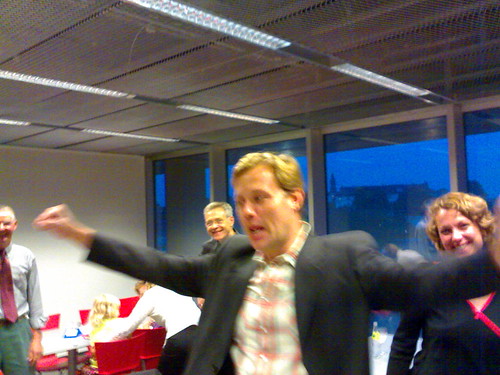Ex-co-PhD student Martin Sønderlev Christensen (of nowuseit fame) defends his thesis masterpiece at ITU tomorrow (14:00, Auditorium 4 or 2).
The thesis is here (draft version).
Update:

By stilleben [‘stelle:bƏn] http://www.flickr.com/people/stilleben/
The abstract reads:
Abstract
This dissertation offers a cultural theoretical interpretation of the emergence of personal affective mobile media [PAMM]. By interpreting the apparent cultural changes and representation of mobile devices, the dissertation provides a description that emphasizes a conceptual shift from understanding technology as efficiency to using it affectively.
This shift is becoming apparent
due to mobile and wireless information technology proliferating into everyday life. The
dissertation carries out the following argumentations to support this observation.
Firstly, the dissertation embarks a historical description of the emergence of the culture of affect
in technology, and how this has come to challenge a predominant culture of efficiency.
In this relation the dissertation argues that the understanding and the underlying disciplines
which generally evaluate and lead the design of information and communication technologies,
at its core need in greater extend to encompass the notion of affect as a design motif. This
“culture of affect” has arrived not because technologies have catered for this in a user-friendly or
hassle-free manner, but because users actively and critically have engaged with these
technologies, while carrying these into the very center of their personal everyday life activities.
Secondly, the dissertation investigates how users are acting with and experiencing technology
beyond the functional. It offers an example driven genre depiction of the way users is able to
form meaningful, personal and thus valuable relations to their mobile technologies.
Affective relations, it is argued are crucial drivers in how people accept, understand and use
technologies in their everyday life. Particular it is analyzed how mobile image technologies are
productive in sustaining an embodied relation to the world through capturing in local contexts
and sharing online experiences of mundane everyday life relations.
Thirdly, the dissertation seek to underpin the consequences of the mobile device by discussing it
through a revising recent empirical studies and a by putting the mobile device into late modern
sociological context. The mobile device here becomes a parenting part of the shift towards
affective and reflexive post-traditional society. From this the dissertation argues following that
the mobile device most be understood beyond its merely functional and transparent role as
verbal and textual commutation devices but a media technology.
As We May Feel | Interpreting The Culture of Emerging Personal Affective Mobile Media
11
Fourthly, The dissertation argues that mobile device technologies is reinserting the real world
experiences in to new media context, which predominantly have been occupied with a virtual
reality relation between user and their technological mediation.
The emergence of Mobile media, it is argued offers locative and corporeal embodiment of
technology, and they are increasingly also creating new forms of media, PAMM, in which users
either contribute, participate or bypass traditional media structures and values.
Fifthly, the mobile device human technology relation is explored by a phenomenological
approach. The Dissertation argues on the basis of the observations originated by PAMM, that the
philosophical approach needs expanded to encapsulate the more dynamic mediation of the
world which is brought forth by these technology, that promotes at the same time upholds
different relations such as an embodied “being-in-the-world” and hermeneutical “reading-theworld”
in one. This lastly leads to discussion of the way in which these technology challenges
design thinking and practices to become more invested in everyday cultural as a critical praxis.
Following this the dissertation conclusively applies five factors in which the emergence of
PAMM, and the “culture of affect” are particular visibly in: Attachment, Augmentation,
Awarness, Articulation, and Action. These are discussed with a typology that re of the user in
And lastly, in a design context it is argued that design research could well engage in
understanding technology as an affective activity related to actions in the world and not merely
as transparent interaction with technology. At this point the dissertation aim at informing and
partaking in a general critical turn in design, trying to establish a framework for understanding
how affect is a key element of how and why technologies becomes meaningful to us, often
despite of easy-of-use and a functional motives.